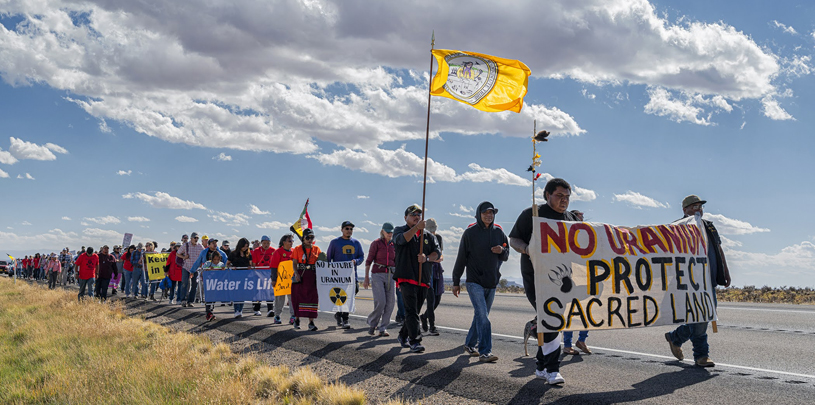
 by Tim Peterson, Cultural Landscapes Director
by Tim Peterson, Cultural Landscapes Director
The White Mesa uranium mill in southeast Utah is a bad neighbor, according to members of the Ute Mountain Ute Tribe's nearby White Mesa community. On October 22, 2022, tribal leaders, elders, and community advocates led a spiritual walk from their small reservation to the controversial uranium mill. The walk, organized annually, marks community and tribal opposition to the White Mesa Mill; this year it drew well over 100 people, the largest crowd to date.
The White Mesa Mill's sprawling waste pits, which spread across about 275 acres and contain more than 700 million pounds of radioactive materials from contaminated sites across the country and the world, sit just a few miles from the White Mesa community and a mile from the boundary of Bears Ears National Monument.

White Mesa community members, tribal leaders, and the tribe's environmental department are concerned that radioactive contamination from the mill could put public health, water, and air quality at risk. The community's drinking water aquifer is located deep beneath the mill's waste pits.
"They dug up our ancestors that were buried there," tribal member Yolanda Badback, whose local group, White Mesa Concerned Community, helped organize the spiritual walk, told supporters. "So that’s why I’m standing up here fighting against this and trying to have clean air and clean water for our people...Because the majority of our people here in our community we don’t drink our tap water, we go out and purchase water to drink."
"The common thing we got here with White Mesa, Blanding, Bluff, and this whole area is water," Ute Mountain Ute Tribal Council Member Conrad Jacket told the crowd assembled outside the community center. "Red, white, blue…I don’t give a care what color you are, if water gets contaminated, then that’s the end..."
In August 2021, the Ute Mountain Ute Tribal Council passed a resolution stating that "the White Mesa Mill has had severe health impacts on the residents of White Mesa" and calling on the mill to cease operations.
Citizens of other tribal nations traveled long distances to support efforts to protect the White Mesa community from radioactive contamination.
"Every step that you take on this Mother Earth is a sacred step, every step is a prayer, every step is an offering. Every inch of this Mother Earth, this Turtle Island, has remains of our ancestors...The prayer walk is a solidarity walk," affirmed Ofelia Rivas who traveled from Tohono O'Odham lands.
Teracita Keyanna of the Navajo Nation, a member of the Red Water Pond Road Community Association, who works to protect her community from uranium industry waste at Superfund sites near Church Rock, in what is now known as New Mexico, told the crowd her association opposed the idea of uranium waste from the Navajo Nation being sent to the White Mesa Mill for processing and disposal.
"That’s not what we want. We don’t want another Indigenous community impacted," Keyanna explained. "The Red Water Pond Road Community Association is in solidarity with the White Mesa mill group here...We’re gonna make sure that we get it [the uranium waste] to a safe place…make sure that our Indigenous people are kept safe," she told the crowd.
Energy Fuels, the company that owns the White Mesa Mill, has touted its interest in processing waste from the Navajo Nation to investors, hoping for a piece of the $1.7 billion the U.S. government has promised for uranium cleanup on the Navajo Nation.
The mill has a history of processing and discarding waste that has contaminated Indigenous lands, including waste from the Midnite Mine Superfund site on the Spokane Indian Reservation in what is now Washington, and Sequoyah Fuels waste on the Cherokee Nation in what is now Oklahoma, transferring the risk from one Native community to another.
In December 2021, the U.S. Environmental Protection Agency barred the mill from accepting Superfund waste after determining the mill was violating the Clean Air Act by not discarding the waste safely, a decision it has since walked back.

According to the Bears Ears Inter-Tribal Coalition, the White Mesa Mill puts the Bears Ears cultural landscape at risk. The coalition's land management plan for Bears Ears National Monument says the mill is the source of "air and water pollution directly affecting the local communities" and affects "the broader cultural landscape of the region." The plan goes on to explain concern that "toxic dust that falls on plants can become a source of carcinogens or toxins to traditional communities whose members collect plants for medicine or consumption," and warning that contamination "may persist for generations."
Ute elder Thelma Whiskers thanked supporters, in Ute and in English, for coming to White Mesa to join the walk. "I know the gas is so expensive and it's good to see you supporting us," Whiskers said. "We’re so happy to see you...brothers and sisters, friends, relatives...thank you."
If you missed the walk, a groundwater permitting process for the White Mesa Mill is expected to open in January 2023, which will be an opportunity to support community members in White Mesa again by sharing your concerns with regulators.
More than 275,000 pounds of radioactive materials imported from the Japan Atomic Energy Agency headed to Utah's White Mesa Mill.
Read MoreWhite Mesa Ute community leaders testify in Washington D.C. about how Utah's White Mesa uranium mill, near Bears Ears, affects their lives.
Read More"We want to have healthy lives. We want to have access to clean water," says Chairman Manuel Heart.
Read More